| |
|
|
|
 |
 |
|
 |
|
 |
|
 |
|
 |
|
 |
|
 |
|
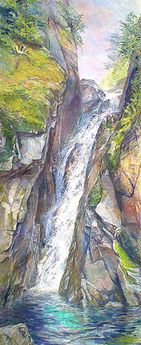 |
The enormous 22 x 9-foot mural was commissioned
in 2001 in honor of the 100th anniversary of the start of business in January
1902 of The Adirondack Trust Company of Saratoga Springs, NY.
Anne Diggory designed "The Flume" to be a visually dramatic experience for the viewers ascending and descending the stairs. Each level of the stairs provides a different view of the falls in the same way that a trail offers glimpses of the natural surroundings. Much of the energy of the painted waterfall comes from the expressionistic style of painting and the juxtapositions of textures and colors that plunge from the sunlit distance through the dark flume and into the opalescent pool. The eye of the viewer is then pulled up the stacks of tilting rock formations to rest again at the top. The bank is located on the southwest corner of Broadway and Church
Street in Saratoga Springs, NY. The stairwell with the mural is located
at the rear of the building near the parking lot. It can be entered
during bank hours, 9-3 weekdays and 9-12 Saturdays (entering on Saturdays
through the offices behind the ATM machine). 584-5844 |
|||||
 Details of mural |
||||||
|
|
|
|
||||
| From the first landing, a sense of enclosure | From the second floor, glimpses of the
top amidst the angles of the climb with light pouring from the skylight
into the waterfall. |
From the third floor, a sense of vertigo, gazing down into the distant pool. | ||||

The initial proposal in February 2001 was based on Diggory's paintings of Mossy Cascade in Keene Valley. The many eye levels of the viewer climbing the stairs were part of the plan. In order to make two full-sized proposals, she then painted at two Adirondack waterfalls, Mossy Cascade in KeeneValley and the Flume of the Opalescent River near Mt Marcy. |
||||
|
|
|
|
||
| The trip to find the flume of the Opalescent River as it had been painted by Alexander Helwig Wyant in the 1870s was featured in The New York Times on June 20th, 2001, as part of an acclaimed 10-part series called In Art's Footsteps, by Kirk Johnson. | ||||
| Return to the Opalescent River | ||
|
In July, Diggory and Catherine Minnery returned to the flume for a
|
|
|
|
|
|
|
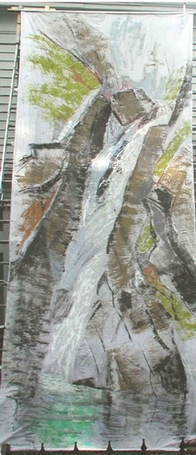 |
Back in the studio, Diggory created a full-sized study on muslin, which was draped off the side of her house along with the Mossy Cascade study so that the bank president, Charles Wait, could make the selection.
|
|
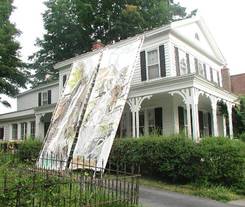 |
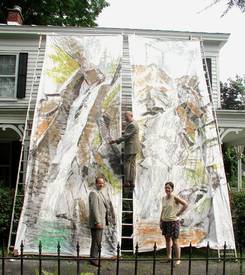 |
|
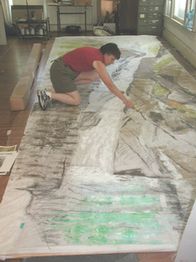 |
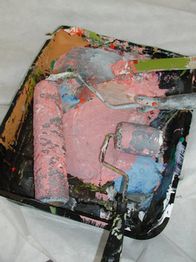 |
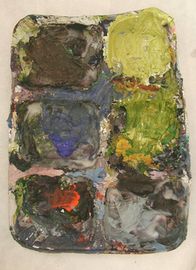 |
||
|
I transferred the major shapes of the full-sized study to a commercially prepared canvas using tulle fabric as a tracing material. |
I worked on the floor of my studio for the first month, mainly using painting mitts and rollers with textured surfaces to lay out the large areas. I have a collection of used rollers, each with a distinct pattern. Large round scene-painting brushes were loaded with paint and rolled on their sides to produce spattering textures. | |||
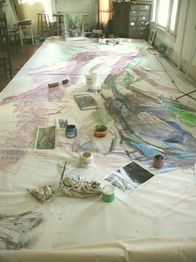 1. |
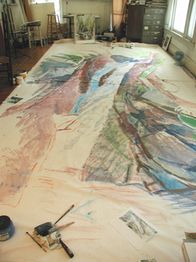 2. |
1. At first I washed in the major shapes to establish the placement and create warm undertones. 2. I established the lower right and upper left quadrants first since I wanted to strongly state the movement across the waterfall. 3. I then added color to all parts so that the bare canvas would refer to the lightest portions. The sky and the lowest part of the water would change the least in following months. 4. Then I added details to all of the areas in order to clarify the masses and the interlocking structure. The expressionistic painting was based on information from on-site artwork as well as digital photographs and ideas about building an illusionistic space. |
||
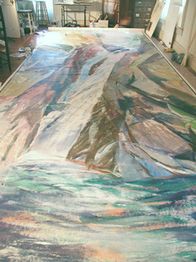 3. |
 4. |
|||
| Before shifting to working on a vertical surface the mural was installed temporarily in the bank stairwell. I spent the day taking notes on changes to make (trimming the bottom, raising the water level by condensing the rock shapes, bringing the upper left rock mass in closer to the water). I then returned to paint at the studio for a weekend. I made most of the adjustments to the upper part of the painting so that I would have to spend less time high up on ladders and lifts. |  |
||
 |
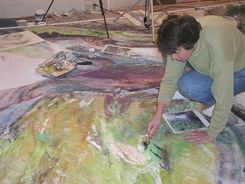 |
||
| Working vertically at the Saratoga Springs City Center for two months | |||
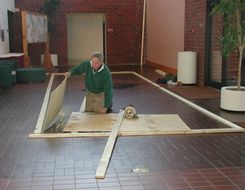 Mike Murray built a wooden structure and attached it to the wall. |
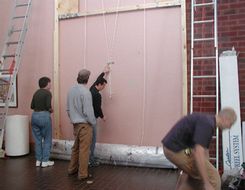 The painting was unrolled, hoisted and stapled at the top by Shaw Fici and Steve Martonis of Art Specs. |
||
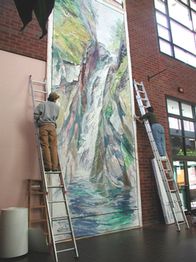 Stapling the bottom half |
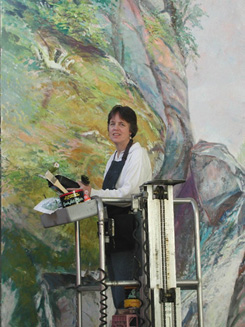 Working on the top with an electric lift |
||
|
|
|
||
|
The mural was rolled up at the City Center and then installed in December
2001 by Art Specs, with assistance from Tim Grande. |
|||
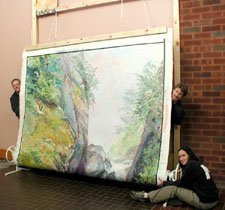 |
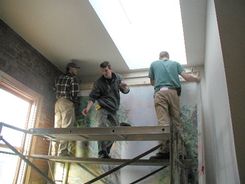 |
||
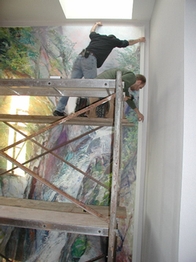 |
 |
||
|
A wooden-frame structure was attached to the wall and the canvas was pulled up in front of it with a pulley attached to a bar. After stapling the canvas to the wood, a frame was attached around the edges. The unveiling came with the removal of the scaffolding. The Installation Celebration was on January 12th. |
|||
| [XX Vertical Photo #1] | [XX Vertical Photo #2] | ||